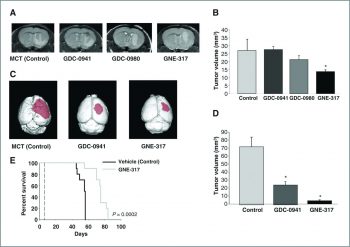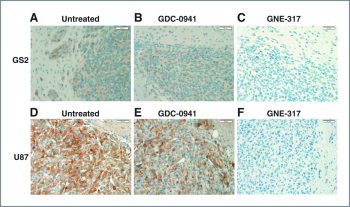
| Size | Price | Stock | Qty |
|---|---|---|---|
| 5mg |
|
||
| 10mg |
|
||
| 25mg |
|
||
| 50mg |
|
||
| 100mg |
|
||
| 250mg |
|
||
| 500mg |
|
||
| Other Sizes |
Purity: ≥98%
GNE-317 (also called A769662;A 769662) is a novel, potent, and selective PI3K/mTOR dual inhibitor with excellent BBB (blood-brain barrier) penetrating ability. With a Ki of 2 nM, it inhibits the PI3K isoform and may have anticancer properties. GNE-317 is not a substrate for the efflux pumps that cause drug resistance, such as P-gp or BCRP.
| Targets |
PI3K; mTOR
|
|---|---|
| ln Vitro |
GNE-317 is not a substrate of P-gp or BCRP transporter in transfected Madin-Darby canine kidney (MDCK) cells. In mouse plasma, GNE-317's binding to plasma proteins shows a 14.9% free fraction, while its binding to brain tissues is higher at 5.4% free. Cytostasis is visible in GNE-317, but U87 cells do not die. [1]
|
| ln Vivo |
GNE-317 (40 mg/kg, p.o.) significantly inhibits the PI3K pathway in the mouse brain, 40% to 90% of the pAkt and pS6 signals being suppressed up to 6 hours after administration. In the U87 and GS2 orthotopic models, GNE-317 (40 mg/kg, p.o.) effectively inhibits tumor growth by 90% and 50%, respectively. GNE-317 (30 mg/kg, p.o.; 40 mg/kg the first two weeks) increases the lifespan of mice from a median of 55.5 to 75 days in the GBM10 tumor model. [1]
|
| Enzyme Assay |
Compounds are serially diluted (3-fold in 100% DMSO) across a 384-well polypropylene mother plate from column 1 to column 12 and column 13 to column 24, to yield 11 concentrations for GSK2126458. Columns 6 and 18 contain only DMSO. Once titrations are made, 0.05μL is transferred to a 384-well low-volume assay plate. This assay plate contains three pharmacological controls (known PI3K inhibitors) and 3 assay controls: (1) Enzyme without inhibitor; (2) Buffer minus enzyme, and (3) Buffer minus enzyme plus native PIP3. DMSO is stamped into all wells of columns 6 and 18. PIP3 is added at 40 μM in 1X Reaction buffer (1μL of 200 μM PIP3) to alternating rows of column 18 (wells 18 B, D, F, H, J, L, N, P). The no-enzyme control reactions are run in wells 18 A, C, E, G, I, K, M, O (0.1μL of 100% DMSO). The PI3-Kinase profiling assay is optimized using the HTRF kit. The assay kit contains seven reagents: 1) 4X Reaction Buffer; 2) native PIP2 (substrate); 3) Stop A (EDTA); 4) Stop B (Biotin-PIP3); 5) Detection Mix A (Streptavidin-APC); 6) Detection Mix B (Eu-labeled Anti-GST plus GST-tagged PHdomain); 7) Detection Mix C (KF). PI3Kinase Reaction Buffer is prepared by diluting the stock 1:4 with de-ionized water. Freshly prepared DTT is added at a final concentration of 5 mM on the day of use. Enzyme addition and compound pre-incubation are initiated by the addition of 2.5μL of PI3K (at twice its final concentration) in 1X reaction buffer to all wells using a Multidrop Combi. Plates are incubated at room temperature for 15 minutes. Reactions are initiated by addition of 2.5μL of 2X substrate solution (PIP2 and ATP in 1X reaction buffer) using a Multidrop Combi. Plates are incubated at room temperature for one hour. Reactions are quenched by the addition of 2.5μL of stop solution (Stop A and Stop B pre-mixed at a ratio of 5:1, respectively) to all wells using the Multidrop Combi. The quenched reactions are then processed to detect product formation by adding 2.5μL of Detection Solution to all wells using the Mulitdrop Combi (Detection mix C, Detection mix A, and Detection mix B combined together in an 18:1:1 ratio, i.e.: for a 6000 μL total volume, mix 5400 μL Detection mix C, 300μL Detection mix A, and 300 μL Detection mix B. Note: this solution should be prepared 2 hours prior to use). Following a one hour incubation in the dark, the HTRF signal is measured on the Envision plate reader set for 330nm excitation and dual emission detection at 620nm (Eu) and 665nm (APC).
|
| Cell Assay |
GL261 is an aggressive C57BL/6J-derived glioma line. Green fluorescent protein (GFP) and luciferase (Luc), which come from different plasmids, are both transfected into this cell line. The resulting monoclonal GL261-GFP-Luc cells are cultured at 5% oxygen and kept alive in Dulbecco's modified Eagle's medium supplemented with 10% FBS and Penicillin/Streptomycin (100 U/mL). For cell selection, 4 mg/mL G418 and 4 mg/mL Puromycin were used. A 96-well format is used for the cellular viability assays, with 2000 cells plated in each well under culture conditions. A 48-hour incubation period with the drug or a vehicle is followed by an MTS assay to determine the viability of the cells. A Synergy Mx automated plate reader is used to measure absorbance at 490 nm to assess viability and at 650 nm to take background into account. The percent survival is calculated by normalizing the numerical data from drug-treated wells to the data from vehicle-treated wells[1].
|
| Animal Protocol |
U87 and GS2 orthotopic tumor-bearing mice
40 mg/kg p.o. |
| References |
| Molecular Formula |
C19H22N6O3S
|
|---|---|
| Molecular Weight |
414.4814
|
| Exact Mass |
414.147
|
| Elemental Analysis |
C, 55.06; H, 5.35; N, 20.28; O, 11.58; S, 7.73
|
| CAS # |
1394076-92-6
|
| Related CAS # |
1394076-92-6
|
| PubChem CID |
70676303
|
| Appearance |
Light yellow to khaki solid powder
|
| Density |
1.5±0.1 g/cm3
|
| Boiling Point |
607.6±65.0 °C at 760 mmHg
|
| Flash Point |
321.3±34.3 °C
|
| Vapour Pressure |
0.0±1.7 mmHg at 25°C
|
| Index of Refraction |
1.699
|
| LogP |
1.2
|
| Hydrogen Bond Donor Count |
1
|
| Hydrogen Bond Acceptor Count |
10
|
| Rotatable Bond Count |
4
|
| Heavy Atom Count |
29
|
| Complexity |
570
|
| Defined Atom Stereocenter Count |
0
|
| SMILES |
S1C2C(=NC(C3=C([H])N=C(N([H])[H])N=C3[H])=NC=2C(C([H])([H])[H])=C1C1(C([H])([H])OC1([H])[H])OC([H])([H])[H])N1C([H])([H])C([H])([H])OC([H])([H])C1([H])[H]
|
| InChi Key |
XOZLHJMDLKDZAL-UHFFFAOYSA-N
|
| InChi Code |
InChI=1S/C19H22N6O3S/c1-11-13-14(29-15(11)19(26-2)9-28-10-19)17(25-3-5-27-6-4-25)24-16(23-13)12-7-21-18(20)22-8-12/h7-8H,3-6,9-10H2,1-2H3,(H2,20,21,22)
|
| Chemical Name |
5-[6-(3-methoxyoxetan-3-yl)-7-methyl-4-morpholin-4-ylthieno[3,2-d]pyrimidin-2-yl]pyrimidin-2-amine
|
| Synonyms |
GNE317; GNE-317; GNE 317
|
| HS Tariff Code |
2934.99.9001
|
| Storage |
Powder -20°C 3 years 4°C 2 years In solvent -80°C 6 months -20°C 1 month |
| Shipping Condition |
Room temperature (This product is stable at ambient temperature for a few days during ordinary shipping and time spent in Customs)
|
| Solubility (In Vitro) |
DMSO: ~47 mg/mL warming (~113.4 mM)
Water: <1 mg/mL Ethanol: <1 mg/mL |
|---|---|
| Solubility (In Vivo) |
Note: Listed below are some common formulations that may be used to formulate products with low water solubility (e.g. < 1 mg/mL), you may test these formulations using a minute amount of products to avoid loss of samples.
Injection Formulations
Injection Formulation 1: DMSO : Tween 80: Saline = 10 : 5 : 85 (i.e. 100 μL DMSO stock solution → 50 μL Tween 80 → 850 μL Saline)(e.g. IP/IV/IM/SC) *Preparation of saline: Dissolve 0.9 g of sodium chloride in 100 mL ddH ₂ O to obtain a clear solution. Injection Formulation 2: DMSO : PEG300 :Tween 80 : Saline = 10 : 40 : 5 : 45 (i.e. 100 μL DMSO → 400 μLPEG300 → 50 μL Tween 80 → 450 μL Saline) Injection Formulation 3: DMSO : Corn oil = 10 : 90 (i.e. 100 μL DMSO → 900 μL Corn oil) Example: Take the Injection Formulation 3 (DMSO : Corn oil = 10 : 90) as an example, if 1 mL of 2.5 mg/mL working solution is to be prepared, you can take 100 μL 25 mg/mL DMSO stock solution and add to 900 μL corn oil, mix well to obtain a clear or suspension solution (2.5 mg/mL, ready for use in animals). View More
Injection Formulation 4: DMSO : 20% SBE-β-CD in saline = 10 : 90 [i.e. 100 μL DMSO → 900 μL (20% SBE-β-CD in saline)] Oral Formulations
Oral Formulation 1: Suspend in 0.5% CMC Na (carboxymethylcellulose sodium) Oral Formulation 2: Suspend in 0.5% Carboxymethyl cellulose Example: Take the Oral Formulation 1 (Suspend in 0.5% CMC Na) as an example, if 100 mL of 2.5 mg/mL working solution is to be prepared, you can first prepare 0.5% CMC Na solution by measuring 0.5 g CMC Na and dissolve it in 100 mL ddH2O to obtain a clear solution; then add 250 mg of the product to 100 mL 0.5% CMC Na solution, to make the suspension solution (2.5 mg/mL, ready for use in animals). View More
Oral Formulation 3: Dissolved in PEG400 (Please use freshly prepared in vivo formulations for optimal results.) |
| Preparing Stock Solutions | 1 mg | 5 mg | 10 mg | |
| 1 mM | 2.4127 mL | 12.0633 mL | 24.1266 mL | |
| 5 mM | 0.4825 mL | 2.4127 mL | 4.8253 mL | |
| 10 mM | 0.2413 mL | 1.2063 mL | 2.4127 mL |
*Note: Please select an appropriate solvent for the preparation of stock solution based on your experiment needs. For most products, DMSO can be used for preparing stock solutions (e.g. 5 mM, 10 mM, or 20 mM concentration); some products with high aqueous solubility may be dissolved in water directly. Solubility information is available at the above Solubility Data section. Once the stock solution is prepared, aliquot it to routine usage volumes and store at -20°C or -80°C. Avoid repeated freeze and thaw cycles.
Calculation results
Working concentration: mg/mL;
Method for preparing DMSO stock solution: mg drug pre-dissolved in μL DMSO (stock solution concentration mg/mL). Please contact us first if the concentration exceeds the DMSO solubility of the batch of drug.
Method for preparing in vivo formulation::Take μL DMSO stock solution, next add μL PEG300, mix and clarify, next addμL Tween 80, mix and clarify, next add μL ddH2O,mix and clarify.
(1) Please be sure that the solution is clear before the addition of next solvent. Dissolution methods like vortex, ultrasound or warming and heat may be used to aid dissolving.
(2) Be sure to add the solvent(s) in order.
|
 |
 |
Clin Cancer Res. 2012, 18(22):6239-6248 Efficacy in orthotopic models of glioblastoma. A, efficacy of GNE-317, GDC-0941, and GDC-0980 in GS2 neurosphere tumor model following treatment with GNE-317 at 40 mg/kg, GDC-0941 at 250 mg/kg or GDC-0980 at 10 mg/kg, daily for 6 weeks. B, GS2 brain tumor volume in control mice and mice treated with GNE-317, GDC-0941, or GDC-0980 for 6 weeks. Results are presented as the mean ± S.E. of 10 animals. C, efficacy of GNE-317 and GDC-0941 in U87 glioblastoma tumor model following treatment with GNE-317 at 40 mg/kg or GDC-0941 at 250 mg/kg, daily for 3 weeks. D, U87 brain tumor volume in control mice and mice treated with GNE-317 or GDC-0941 for 3 weeks. |